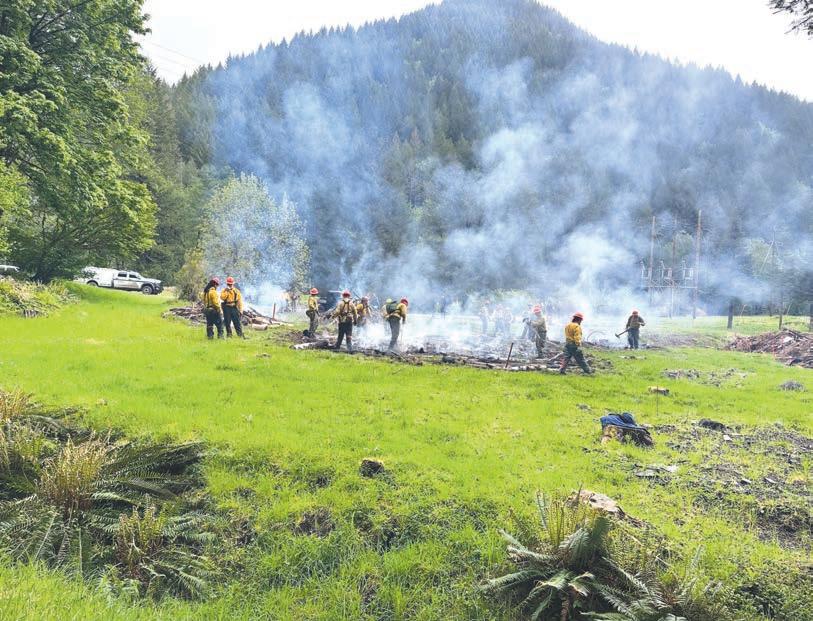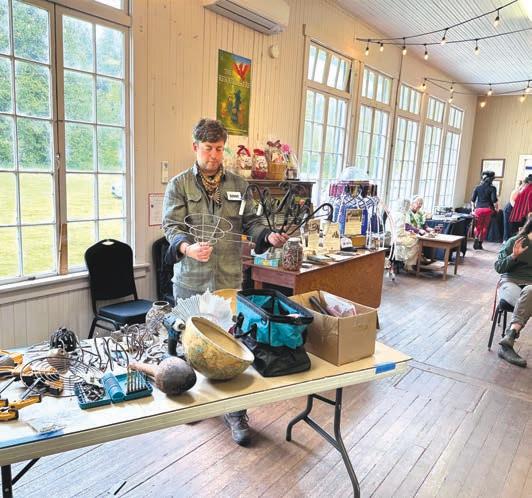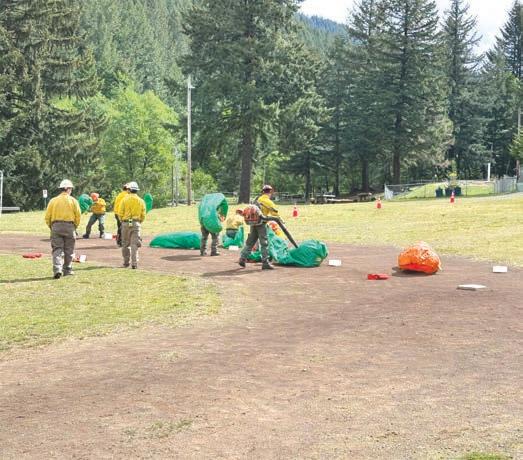

Graduation Keepsake Edition



South Fork Forest Camp holds fire school
WILL CHAPPELL Citizen Editor
South Fork Forest Camp held its annual fire camp for its adults in custody last week, with a field training day held on May 14 to give the students a chance to practice skills in a hands-on environment.
Inmates at South Fork Forest Camp, jointly operated by the Oregon Department of Correction (DOC) and Oregon Department of Forestry (ODF), have been fighting fires since the camp was established in 1951, and ODF Assistant Camp Manager Dana Turner said that those in the program value the opportunity.
“and I would say most of these guys want to be here.”
“It’s a privilege to be at this camp, it’s the only fenceless minimum-security camp in the state of Oregon and it’s a privilege to be here,” Turner said,
Founded in response to the Tillamook Burn, the series of four fires that leveled the majority of what is now the Tillamook State Forest between 1933 and 1951, South Fork Forest Camp is located a little over a mile and a half off Highway 6, near milepost 28, and is home to 125 adults in custody. Those at the camp all have
less than five years remaining on their sentences and are selected for the program by a committee of staff members. All participants must have been incarcerated for at least six months by DOC, and they are selected based on a variety of criteria, including their behavior, victim profile and time left to serve.
See SOUTH FORK, Page A3
Garibaldi Fire chief resigns amid budget controversy
WILL CHAPPELL Citizen Editor
Garibaldi Fire Chief Jay Marugg resigned, effective immediately, at the city’s regular council meeting on May 19, citing the removal of a firefighter position from the department as the cause.
Marugg said that his attempts to find a solution to avoid the cut during the budgeting process were rebuffed by City Manager Jake Boone. Marugg argued that the department brought in enough revenue to pay for the position and said that ending his 30-year career had been a difficult decision.
“This was my fire career, this was
embarrassing, like I said, this is a death in the family,” Marugg said. “They shouldn’t get away with having a toxic situation and pushing me out.”
Boone said that Marugg was mistaken about the possibility of keeping the current staffing levels at the department and that the budget cuts to the fire department were part of a larger trend as the city tries to reign in its spending and rebuild reserves.
“The city has been well overspending its revenues every year,” Boone said, “and so we have to cut back down to not only where we are not spending more than we bring in each year, but we also have to spend even less because we have a huge hole to fill back in that has been dug over previous years, so every department is suffering cuts.”
Prior to Marugg’s resignation, Garibaldi’s Fire Department, which also serves the adjoining Garibaldi Rural Fire Protection District, had two and a half full-time employees and one seasonal firefighter in the summer months, with Marugg serving as chief in a half-time capacity, and Blake Paulsen serving as deputy chief. The department’s budget is supported by a levy in city limits that generated $189,000 this and is earmarked for one and a half positions, a rural levy that generated $204,000 this year, transfers from the general fund and revenues from fighting wildland conflagrations.
Marugg said that tension began to build with Boone several months ago as the budgeting process got under way and cuts were proposed. Marugg said that he believed the funds generated by the levies and fighting conflagrations elsewhere should be able to support the current staffing level but that he felt Boone had been angling for a change in leadership and used the disagreement as a pretext to force him out.
“Through this whole process it was very clear to me that he wanted a leadership change,” Marugg said, “then the council got involved and they didn’t raise a finger.”
Not so, says Boone.

Boone admitted that as part of the budgeting process he had wanted to reevaluate the configuration of staffing in the department, saying that he believed it would behoove the city to have a fire chief who was employed full time and present dur-
ing daytime hours (Marugg worked in the evenings).
Boone also pushed back on the notion that the department was self-sufficient financially, pointing out that the city levy did not pay for the entire cost of the one and a half positions it was intended for, necessitating transfers from the city’s general fund. Boone also said that revenues from fighting out-of-area conflagrations for the department were paltry compared to the income for individual firefighters.
“We pay firefighters while they’re gone for the time that they’re spending fighting those fires, and then eventually we get paid back,” Boone said, “that is not the same thing as saying look at this amazing windfall.”
As part of the ongoing discussions around the department, Boone offered to allow Marugg and Paulsen to switch roles, with Marugg agreeing, until he found out that the second full-time position was still on the cutting block, at which point he decided to resign. Marugg was joined in his resignation by volunteer Martin McCormick, who also announced his decision at the council meeting and voiced his displeasure with the budgeting process.
Boone said that he had appointed Paulsen as interim chief and begun the recruitment process for a permanent replacement, inviting Paulsen to apply.
Boone and Mayor Katie Findling voiced their confidence in Paulsen’s abilities and the ability of the department to perform its duties after the switch. Both also stressed that the decision had been driven by financial necessity, not personal animus, and mirrored in other city departments.
“It’s really, really tough to put on a business hat or a fiscal-responsibility hat,” Findling said, “and recognizing that every single department had a position cut, so it’s not just fire.”
To wit, the proposed budget includes funding for one fewer employee in both public works and the city’s front office, and a discontinuation of the city’s contract for patrol services with the Tillamook County Sheriff’s Office.
Boone said that for several years, the city has been spending more money that
With five days left for ballots to arrive, the vote on whether to raise Tillamook County’s transient lodging tax from 10% to 14% was nip and tuck, with 20 more no votes counted as of the second round of results released on May 22.
Support for measures seeking a bond for facilities improvements in the Tillamook School District and a levy to support operations in the NeahKah-Nie School District increased with 56.1% of votes tallied in support of the former and 59.3% for the latter.
Results held steady in school board races for all three county districts as well, even after around more than 2,000 votes were received by the clerk’s office on election day. Tillamook County Clerk Christy Nyseth told the Headlight Herald that the county had seen the highest voter turnout in the state, with 42.3% of eligible voters having cast an accepted ballot.
Nyseth said that all votes received by election day had been counted, but that 600 votes postmarked by election day are in her office’s possession and yet to be counted, with those results to be released by May 29, along with any more ballots postmarked by election day that arrive by May 27.
There are also 66 ballots with challenged signatures and 38 with no signature, whose casters have until June 10 to clarify their signatures. Nyseth’s office must certify the election results by June 16.
After the second round of vote results were released, measure 29-183 seeking to increase the county’s transient lodging tax rate for the first time since its 2014 institution had received 4,276 votes in favor, with 4,296 opposed.
With results so close, the race
TLT increase hangs in balance NCRD welcomes new director
WILL CHAPPELL Citizen Editor
Nehalem’s North County Recreation District greeted a new executive director in early May, with Justin Smith taking over the role from Barbara McCann.
Smith comes to the North County Recreation District (NCRD) from the Sunset Empire Parks and Recreation District in Seaside, bringing a background in aquatics and youth programming to the role, and said that he is excited for the opening of the district’s new pool facility in early July.
“It’s going to be huge,” Smith said, “I just feel like it’s going to bring dollars to this town in particular, dollars to the town of Manzanita and then just a place for the community to play.”
Smith was born and raised in a suburb of Sydney, Australia, and first came to the United States in his early 20s to work seasonally at a YMCA summer camp in Potosi, Missouri. There, Smith met his wife, and after a brief stint in Australia, the pair settled in the Kansas City
Trainees practice mop-up operations to prevent hot spots using several controlled burns.


Trash Bash Art Fest kicks off with Trash Art Slam
annual Trash Bash Art Festival kicked off with a gallery opening reception featuring a live art demonstration by three artists at White Clover Grange on May 15. The three-day event continued with a Trash Tales storytelling event on May 16, and culminated with the annual Trashion Art Show on May 17. Heart of Cartm Executive Director welcomed attendees to the kickoff event on Thursday, saying that the weekend was an excellent opportunity to show off Heart of Cartm’s mission.
“We are asking you to come out of hibernation to help us
celebrate the creativity and resourcefulness that characterize this community all year long,” Just said.
Heart of Cartm began in the late 1990s as a nonprofit focused on reducing waste and managing it locally and ran the Manzanita Transfer Station for two decades until 2018.
Reinvigorated by a new board in 2021, the organization opened a new workspace in Wheeler where they repurpose materials donated by community members or rescued from the roadside or rubbish piles into art, which is then sold. The Trash Bash Art Festival, held each May, gives the group an opportunity to show off its members’ skills in repurposing and to raise funds through fun events and
art
At the opening reception, artists Shel Stout, Senny Siegel and Wenda Borge showcased their artistic talents in a Trash Art Slam, where each of the artists was given three hours to craft a piece out of donated materials. Artists spent the first hour choosing their materials, half an hour arranging them and an hour and a half assembling, with the help of an assistant, and audience members were welcomed to help or ask the artists questions about their process.
Attendees were also able to peruse more than 70 pieces of art that were on display in the grange, with many for sale, while enjoying donated hors d’oeuvres and drinks.

Braver Angels hosts urban rural divide townhall
WILL CHAPPELL
CITIZEN EDITOR
Braver Angels, an organization seeking to bridge the partisan divide in the United States, hosted a town hall to discuss the urban rural divide at the main branch of the Tillamook County Library on May 17.
At the meeting, residents were invited to share their views on the split and said that they felt there were lower expectations for rural areas that were leading to an uneven distribution of funding for social services to the disadvantage of their residents.
The town hall started with a moderator describing the process Braver Angels is using to try to achieve their goal of bridging the gap between people in the city and the country. He said that the group was in a three-stage process of developing a report with suggestions for legislators that will then be taken to Salem.
The first stage of the pro-
cess was a series of debates held last summer about whether the divide is insurmountable. This summer’s town halls mark the second stage and will be followed by a series of moderated discussions including people from urban and rural settings during which the list of suggestions will be developed.
The moderator explained that the goals at the town halls were to listen and learn about the causes of and problems created by the divide, explain Braver Angel’s mission and select participants for the fullday, moderated discussions. After the introduction, attendees began sharing their opinions.
Residents said that there were many drivers of the divide, noting that there were fundamental differences in the lifestyles that urban and rural people had, as well as in the services they had access to.
Several pointed out that the divide existed even within Tillamook County due to the

large number of urbanites that own second homes in the area or have retired here, with one attendee saying that some of their neighbors did not feel comfortable in Manzanita because of a cultural divide.
Conversely, attendees noted that longtime residents of the county belong to tightknit communities formed around certain vocations and activities, a dynamic that can make finding a community difficult for outsiders. One attendee said that she felt the community would benefit from creating more spaces for community building outside of the longstanding organizations populated by locals.
Beyond the urban-rural divide in the county, another attendee said that a divide also existed along economic lines, with different markedly lifestyles for those that have the money to drive to the Willamette Valley to access services and those who struggle to eke out a living on the coast.
That observation prompted
several to discuss the relative lack of social services available to rural residents, which they said is especially apparent in schools. An attendee argued that state social service programs should give baseline funding to each of the state’s counties before applying population-based formulas for allocation to ensure that each county is able to provide the intended baseline services.
Tillamook County Commissioner Erin Skaar chimed in that social services, beyond seeing a relative lack of funding in rural areas compared to urban, were also unable to take advantage of economies of scale in responding to needy residents in rural contexts.
Skaar also pointed out that urban counties had far more legislators representing them than their rural counterparts, with Marion County, for example, sending seven state representatives and senators to Salem versus the two shared between Tillamook, Clatsop,
Columbia and part of Washington County. Skaar said that this meant a Marion County commissioner had seven opportunities to find a legislative champion for an issue, whereas she had just two.
Another speaker said that the discussion about the urban rural divide needed to focus less on the mindsets of the respective groups and more on ways to create economic parity among the two sides. The commenter argued that mechanization in natural-resource extraction industries that have been historical engines of rural economies had devastated those economies. She argued that the key to bridging the divide was developing a vision for rural economic vitality that didn’t look to the past and that would allow rural residents to move past an anti-government mentality.
Skaar agreed that creating alternative economic opportunities was important but noted that it was also important to acknowledge the sense of loss
that had been created by the loss of jobs in natural resource industries.
After the discussion, a member of Braver Angels wrapped up the meeting by discussing the project’s next steps. She explained that the Tillamook town hall was the fifth that the group had held, and they would be holding them in all 36 of Oregon’s counties. She said that the group was also working to raise money to pay for moderation during the full-day discussions that will follow the town hall as well as transportation expenses for participants.
Work has also begun on building support in Salem, with a bipartisan caucus already formed and working to add members, she said, encouraging attendees to call their representatives to mention the project. She said that the group hoped to adopt a plan to guide legislators in accounting for the divide in the next two years.






Jessi Just interviews artist Wenda Borge during the Trash Art Slam on May 15.
Senny Siegel contemplates how he will arrange his materials.
More than 70 pieces of art were on display at the gallery opening event.

South Fork Forest Camp
From Page A1
All participants earn a wildland firefighter type II certification during the annual May camp, where they learn skills like mopping up a burned-over area, creating a fire line, laying hose and using fire shelters. With this certification, maintained in annual refresher courses, program participants are eligible for wildland firefight-
ing positions in the public or private sector upon release, and Turner said that ODF had hired two ex-participants this year alone.
“So, Department of Forestry, we do hire ex-adultsin-custody who’ve been through South Fork, which is pretty cool,” Turner said. During the fire season, crews typically respond to fires within a three-hour drive, according to Turner, though they can also travel farther to larger conflagrations for up to 14 days. Much of the crews’ work focuses on mop-up and line-
cutting activities, but Turner said that last year they had several opportunities to participate in initial attacks as well.
Flynn Lovejoy, one of the firefighters who has been at South Fork for a little over a year, said that he had come from Snake River Correctional Facility in Eastern Oregon and was excited to be at South Fork. Lovejoy said that he thought the opportunity could provide an “awesome segue” back into society upon his release and that he enjoys being able to fight

fires while in custody.
“It’s incredible,” Lovejoy said, “being able to go out and fight fires while I’m incarcerated in prison, it’s super cool.”
While not responding to fires during the summer months, crews spend their time maintaining recreational assets in the adjoining state forests, including by making signs in a workshop at the camp. In the winter months, their focus pivots to forest management, including thinning operations, prescribed burns and other reforesta-
tion efforts.
Firefighters in the program work 40 hours weekly and earn $112 monthly, plus an additional $20 for any day spent responding to a conflagration. They can also earn a wildland firefighter type I certification following their initial training by helping in the training of others and responding to a variety of different scenarios in the field.
At the field training day, ODF firefighters and seasoned program participants manned four stations
spread across the camp’s grounds to reinforce a week of classroom learning. At one, trainees practiced clearing burned over areas of pieces of hot wood in a safe manner to prevent flare ups, while at another they got hands-on experience cutting a fire line with the various tools of the trade. Another station saw the fighters learn the proper way to unroll and reroll hose, while the final station consisted of drilling the use of emergency shelters, used when a fighter is overtaken by a conflagration.
Nehalem Bay Crab Derby 2025: A Day of Fun, Crabs, and Community Giving
Get ready for a claw-some time at the 2025 Nehalem Bay Crab Derby, where Kelly’s Brighton Marina and Jetty Fishery are joining forces to host a vibrant community event to raise funds for local charities. Mark your calendars for a day packed with fun, food, and festivities that celebrate the spirit of Nehalem Bay!
This year’s Crab Derby promises a full lineup of exciting activities for all ages.
TLt
Increase
From Page A1
could possibly be headed for a recount, which would be triggered if the vote differential fell lower than 17, given the current number of ballots received, according to Nyseth. If the margin falls below the threshold, a hand recount would be triggered after results were certified by the secretary of state’s office.
In races for the Tillamook School District board of directors, Kenny Lee Oleman led Amanda Ferrat and Misty Burris in a
From Page A1
it takes in, drawing down reserve funds to bridge the gap, and that those funds have now been depleted, forcing the city to being drawing down its local government investment fund, which currently has a little over $2 million remaining. Complicating the process, the city is still in arears on their financial audits dating back to 2021, after previous administrations failed to have the audits completed. This means that Boone does not have a clear picture of whether funds were legally spent in past years, which could force the city to make transfers between its funds to comply with state law, further exacerbating its financial issues.
Boone said that the city had recently received the preliminary audit for 2021 that showed the situation was worse than expected and that the staff were preparing for even worse news in future audits, which Boone said should either be completed by November or next spring. “We’ve got 2020-2021
Test your skills at rope coiling races, get creative with crab shell painting, try your luck at the buoy toss, or dive into the oyster eating contest. The main attraction?
26 tagged crabs with cash giveaways up for grabs! Plus, enjoy silent auctions filled with unique treasures and groove to live music in the evening will be the end to a perfect day.
“We’re thrilled to partner together to bring this beloved
three-way race for position one, with 51.9% of votes counted, Natalie Rieger led Brandon Affolter in the race for position two with 61.3% of the vote and Ryan Lewis led Jordan Wolfe for position three with 57.6%. Jeannie Christensen was unopposed in the race for position five.
In the Nestucca Valley School District board of directors’ races, Sherry Hartford led Irene Barajas in the race for position one with 29.5% of the vote to Barajas’s 42.9%, Kayla Cole led Seth Belsey with 51.1% of the vote in the race for position two and Jason Hagan led Marty Wisehart in the race for position five with 51.4% of
numbers, and we could plug those in, and it tells us that we are in worse shape than we thought we were, we have less money now,” Boone said. “We also know that there were big issues that happened between 20202021 and now, so we are expecting, as future audits come in, we are expecting the numbers to, at best, not get worse, but we’re also bracing ourselves for them to get worse.”
Given this, Boone said that it was critical for the city not to draw down its available funds any further and to
event to life and support our local charities,” “The Crab Derby is more than just a fun day—it’s a chance for our community to come together, celebrate our coastal heritage, and make a difference.”
Join us at The Jetty Fishery and Kelly’s Brighton Marina, on Saturday, June 7th, 2025 from 9:00 AM to 6:00 PM. Admission is free, so come and enjoy the day. To participate in the tagged crab cash giveaway, it’s $10 per ticket
the vote. Greg Woods was unopposed in the race for position four.
State Senator Suzanne Weber was on track for a victory in the race for position three on the Tillamook Bay Community College’s board of directors, having received 65.7% votes tallied against Jim Heffernan.
Tillamook County Transportation District’s two contested races were on track to see David McCall elected to position one with 59.9% of the voter and Vern Ressler elected to position three with 52.8% of the vote. Eric Sappington and Gary Hanenkrat were unopposed in races for positions five and seven, respectively.
begin spending less money than it takes in to begin rebuilding reserves. Boone said that the decision to cut fire department and other staffing had been difficult but necessary and pointed out that while he and current city staff were having to make the cuts, they had not been responsible for their necessity.
“We should also point out, I’m new, our finance director’s new,” Boone said. “The people that are here now, we’re not the ones who did this. We’re the ones trying to clean up this mess.”
with all proceeds benefiting the Muddnick Foundation, the Animal Haven by the Sea, Neah Kah Nie Junior Baseball Organization and the Rockaway Beach Lions Club.
Don’t miss this unforgettable day of coastal fun,
friendly competition, and giving back to the community. For more information, contact The Jetty Fishery at 503.368.5746 or at www.jettyfishery.com or Kelly’s Brighton Marina at 503.368.5745 or visit wwwkellysbrightonmarina.com.
About Kelly’s Brighton Marina Kelly’s Brighton Marina and the Jetty Fishery are cherished Nehalem Bay destinations offering crabbing, camping, fresh seafood, and a warm community atmosphere.





Future firefighters practice unrolling lengths of firehose.
A drill to practice using emergency shelters was held on the camp’s baseball field, with instructors simulating the high winds of a fire with a leafblower.












































































Church Services by the Sea Cannon Beach to Nehalem



























Nehalem










Nehalem Bay










































































United Methodist Church 36050 10th Street, Nehalem, OR (503) 368-5612

















Pastor Celeste Deveney + Sunday service 11 a.m. Food Pantry







































Contact Katherine at (503) 842-7535, headlightads@countrymedia.net Misc Wanted 790



















Open Friday, Saturday & Monday 10 a.m. to 2 p.m. Wednesday


































































March - October 2 p.m. to 6 p.m.









November - February noon to 4 p.m. Nehalem Senior Lunches











Tuesday & Thursday served at noon email: nbumcnsl2020@gmail.com






To feature your spiritual organization on this panel:






































North Coast


Serving North Tillamook County since 1996
Chief Executive/Operations: Joe Warren










Deadline: FRIDAYS at Noon for Advertising, News, Letters, Classifieds, Legals/Public Notices, Obituaries
Editor: Will Chappell, email headlighteditor@countrymedia.net
Advertising: Katherine Mace, email headlightads@countrymedia.net Office Manager: Patty Archambault, email classifieds@orcoastnews.com
Classifieds & Legals/Public Notices: Due by Noon on Fridays the week of publication, send Classifieds to classifieds@orcoastnews.com, send Legals/Public notices to legals@orcoastnews.com, or call 503-842-7535 for more information.
Graphic Design: Steph Baumgart Office Phone: 503-842-7535 Website: northcoastcitizen.com
The North Coast Citizen (15503909) is published biweekly by Country Media, Inc. 1906 Second Street, P.O. Box 444, Tillamook, OR 97141 SUBSCRIPTION RATES
$60.00 annually in-county; $72.00 annually out-of-county. $50.00 for online only.
Periodicals Postage paid at Tillamook, OR. POSTMASTER
Send address changes to P.O. Box 444, Tillamook, OR 97141
Member Oregon Newspaper Publishers Association (ONPA) © 2025 by the North Coast Citizen. All rights reserved. LETTER POLICY
The Citizen welcomes letters that express readers’ opinions on current topics. Letters may be submitted by email only, no longer than 300 words, and must be signed and include the writer’s full name, address (including city) and telephone number for verification of the writer’s identity. We will print the writer’s name and town of residence only. Letters without the requisite identifying information will not be published. Letters are published in the order received and may be edited for length, grammar, spelling, punctuation or clarity. We do not publish group emails, open letters, form letters, third-party letters, letters attacking private individuals or businesses, or letters containing advertising. Deadline for letters is noon Fridays.
The date of publication will depend on space. Obituaries
The North Coast Citizen has several options for submitting obituaries.
• Basic Obituary: Includes the person’s name, age, town of residency, and information about any funeral services. No cost.
• Custom Obituary: You choose the length and wording of the announcement. The cost is $100 for the first 200 words, $75 for each additional 200 words. Includes a small photo at no additional cost.
• Premium Obituary: Often used by families who wish to include multiple photos with a longer announcement, or who wish to run a thank-you. Cost varies based on the length of the announcement. All obituary announcements are placed on the North Coast Citizen website at no cost.


Fournier pushes for Highway 6 fix
WILL CHAPPELL
CITIZEN EDITOR
Following a landslide in late 2024 that caused significant damage to Highway 6 near mile marker 35 in Washington County, Tillamook County Commissioner Paul Fournier is looking to build support for a permanent fix to address the two active slides in the area.
While Oregon Department of Transportation (ODOT) crews address issues as they arise and are examining longer-term solutions, Fournier said that he is concerned a major storm could knock the roadway out for months, a situation he feels the counties and ODOT should be prepared for.
“I’m just trying to raise the alarm because we will be devastated if that thing is closed for any length of time,” Fournier said, “like our TLT, you know, we’re relying on that, people who long-term visit will make that trip around, but overnight visitors won’t.”
Highway 6 was built during the great depression by workers from the Works Progress Administration, providing the first direct road link between Tillamook County and the Willamette Valley.
Unfortunately, the section of the 48-mile highway crossing through a pass in the coastal range, between mile markers 31 and 37, was constructed on unstable slopes, leading to damage to the road as early as the 1950s, according to Mindy McCart, a public information officer for ODOT.
McCart said that the section of the road at the counties’ border is on an unstable slope that is prone to landslides and ground movement that cause ongoing damage, including broken and sunken pavement.
Geotechnical experts from ODOT have monitored the area for years, according to McCart, and have identified two major landslides around mile marker 34.8, which move by a quarter or inch or more some weeks. During the summer months, ODOT crews repave the sections most damaged by the slides, which they then maintain as best they can through the winter months.
While no concrete plans or funding for longer-term fixes currently exist, a 2023 safety study, funded by a bill sponsored by State Senator Suzanne Weber, found that addressing 18 priority unstable slopes between mileposts 31 and 35 would cost between $38 and $49.4 million. McCart said that ODOT engineers were also looking at less expensive repair options, including new retaining walls or a possible road realignment away from the most unstable areas, with price tags ranging from $6 million to more than $20 million.
Even those smaller figures outstrip available resources, though, with McCart saying that it would take years to pull that kind of money from the department’s regular maintenance budget and necessitate cutbacks on other services across the state.
While there are currently $30 million in projects scheduled for Highway 6 over the next three years, they will upgrade roadside barrier safety ($11 million), pave and repair the road between mile posts four and nine ($9 million), upgrade and repair the bridge over the Devils Lake Fork of the Wilson River ($8 million), improve safety at the Wilson River Loop intersection in Tillamook ($4 million) and replace lighting in Banks ($1.7 million), with

no work planned to address unstable slopes. That’s where Fournier comes in.
After taking office at the beginning of the year, Fournier turned his attention to the highway in April, first making a Facebook video showcasing the road’s condition at the point of the slide that has amassed more than 35,000 views.
Building on the obvious concern from constituents, Fournier had a meeting later in the month with officials from ODOT and the Oregon legislature’s joint transportation committee, including Weber. At the meeting, Fournier said he was advised to keep raising awareness about the road’s importance and condition with as many state and local leaders as possible to try to build support for a solution. Fournier has taken that suggestion to heart and this month has a meeting scheduled with Washington
County Commissioner Jerry Willey, as well as a presentation before the North West Area Commission on Transportation, an intergovernmental agency working on transportation issues with members from Tillamook, Clatsop, Columbia and Washington Counties.
Though the area of most concern lies in Washington County, Fournier said that based on his initial conversations, the road was less of a priority issue there, but that he hopes to marshal more support for fixing it by increasing awareness.
Fournier noted that if the road was knocked out completely, as it was for two months following a slide on the Tillamook County side of the pass in 1991, federal funding would quickly flow for a fix, but the economic impacts would be severe.
Ideally, Fournier said that he would like to figure out a solution to mitigate those impacts in advance of
an emergency, possibly by building a backup road.
“Should we be think
ing about putting a road up through the forest,” Fournier wondered, “a different road, not a big road like that but a smaller, paved road, like it would be a scenic road, and it would get you over to the valley quicker than going around.”
Failing that, Fournier said that he would at least like to see a plan developed for addressing a road failure so that the repair process would be as speedy as possible if that possibility occurred. Fournier said that he would like to see some of the $30 million allocated for current projects diverted for that purpose, as the road’s functionality should be top priority. “It’s not what we need right now, we just need a road that’s not going to collapse,” Fournier said.
While working to devise a solution to the problem,
Fournier is also gathering information from local businesses and residents about the impacts an extended closure of Highway 6 would cause to demonstrate the road’s importance. Fournier said that an official from the Tillamook County Creamery Association had told him that diverting their traffic around a closure would cost $66,000 weekly. On a recent day when Fournier and the Headlight Herald traveled to milepost 34.8, within minutes of exiting the car, a truck hauling two trailers of wood products came to a slow stop after it sounded like an air line disconnected while traversing the warped pavement. The truck continued tentatively after an inspection by the driver, and over the course of 15 minutes at the roadside, we watched a dozen more big rigs do the delicate dance of negotiating the treacherous section.
On the downhill side of the road, the severity of the issue came into focus as we examined the various fissures, holes and stacked layers of pavement that constitute the roadbed for 8,000 daily vehicle trips in the summer months. The broken straps and various pieces of bodywork and engine that had been ejected from passing vehicles and come to rest at the roadside drove home the hazards of negotiating the stretch.
“Anyone that drives over Highway 6 with any frequency knows how bad this road is, but to get out and walk along its edges, you really see the magnitude of the slide and there are pieces of trucks, cars and broken tiedown straps everywhere,” Fournier said. “I invite everybody to send their Highway 6 stories to timetofixsix@gmail.com. I think together we can raise awareness of the need to fix the road to the people that can make it happen.”
Interim Wheeler manager discusses budget
WILL CHAPPELL
CITIZEN EDITOR
Wheeler’s city council promoted Madison Chesnut to the position of interim city manager at their March meeting, following the resignation of Wesley Wootten.
Chesnut, a Nehalem native who has been with the city for two years, is beginning a night school master’s program at Southern Oregon University this fall, at which point she will return to her position as finance manager for the city. Before then, Chestnut is helping the city through its recruitment of a new manager as well as the ongoing budgeting process.
As part of the budget, Chesnut included two new fees and an increase as part of her initial proposal and said her focus is maintaining stability to allow ongoing projects, especially one at Gervais Creek improving stormwater management, to progress.
“My primary goal is to, at least in the interim city manager position, is to keep all these projects that the city has moving forward,” Chesnut said, “I don’t want to see any lapse in that just because
we’re in kind of dire straits right now with the budget.”
Chesnut grew up in Nehalem before attending Oregon State University, where she earned a bachelor’s degree in public policy, after which she spent several years as a social worker. When a position opened in Wheeler in 2023, Chesnut applied and has since worked under three city managers before stepping into the interim role when Wootten left.
Chesnut said that she plans to continue working in the public sector after completing her master’s degree, but that she will most likely focus on finance rather than city management, which she said does not play to her strengths.
“City management just really isn’t my forte,” Chesnut said. “But I do think that it’s helpful to have the policy background in addition to the experience I’ve gained in this role, and also, you know, the financial pieces that are gained for my master’s.”
The financial puzzle of piecing together a budget for a small city in Oregon has never been more complex, as costs continue to rise while revenue-generation oppor-
tunities are limited. This led Chesnut to propose a total cut to the city’s general fund for next fiscal year of $60,000 in materials and services, to avoid a negative cash flow in the general fund’s $460470,000 budget.
As part of the budgeting process, Chesnut also proposed three potential changes to the city’s fees to allow the city to prevent cuts to services that are important to residents.
The first proposal was for a monthly fee of $5.69 per property to pay for the city’s contracted law enforcement services with the Manzanita Police Department. Those services cost around $23,000 annually for 15 hours of monthly patrol, up from $14,000 last year, and Chesnut said that she knew they were important to residents.
“The two things that have been identified as kind of focuses for citizens by counselors have been traffic calming and emergency services, they’d like to see more police presence,” Chesnut said. “So, I think that cutting police services isn’t something that citizens would like to see.”
To address the second citizen priority, transporta-
tion, Chesnut proposed a per property monthly fee $4.83 to raise $19,500 for street maintenance. Wheeler’s street fund currently receives 50% of the utility franchise fees collected by the city as well as the city’s portion of the state gas tax, amounting to about $50,000, as well as more than $300,000 earmarked from an Oregon Department of Transportation small city allotment to address concerns at 4th and Vosberg.
However, most of the regular revenues will be spent on staff time related to street work leaving just $13,550 budgeted for maintenance work. While the budget was higher this year and Chesnut said that the city will complete as many high-priority projects as possible before July, doing projects beyond vital repairs next year would be contingent on the fee being approved.
The final revenue boosting proposal is an increase in the city’s stormwater drainage management fee from $5 to $11 to help maintain the city’s system. The fee was last adjusted in 2006. Chesnut stressed that the ideas were just proposals and
that it would be up to council to weigh their value before deciding whether to adopt them. She said she appreciated the economic strain faced by community members and encouraged them to offer feedback on how the proposals would impact them at upcoming meetings.
“It’s hard out there right now to be paying all these additional fees,” Chesnut said, “your water bill’s high, your taxes are high, grocer-
ies are high, everything’s high. And so, it’s just difficult for the typical person to get by, so I want to hear as much input from the community as I can about your feelings on any increases that we have.”
Editor’s note: A version of this story originally appeared in the May 15 edition, but contained several factual errors, including Chesnut’s plans for the fall and budget specifics.
Fournier surveys the edge of the slide at mile marker 34.8.
The downhill side of the road at the slide site is fissured and the layers of pavement, as well as wood chips, used in various repairs over the years are clearly visible.
Cracks and patches abound on the roadway in the areas affected by slides.
Local Business Spotlight
Fresh from crust to crust: Crab Rock Pizza
The people of Tillamook County have spoken: their favorite pizza comes from Crab Rock Pizza. The establishment has earned first place two years in a row from the Tillamook Headlight Herald’s People’s Choice Award in the category of pizza. The business is a member of the North Coast Food Trail, makes their own gelato in house and woodfires pizza inside an oven that has bricks made from the ash of Mt. Vesuvius.
Behind the business that is so popular that it’s bursting at the seams and looking to add another location are married couple Bill Thoms and Theresa Seifer, who opened Crab Rock Pizza in November 2022 at the Port of Garibaldi.
“We started looking around and fell in love with Garibaldi. It’s got mountains and the sea. We see bald eagles every day. We’ve seen killer whales out in the bay,” Thoms said. “We thought: ‘What does this area need?’ There wasn’t any real pizza restaurant [at the time].”
Once settled on a food category, the couple spent time researching what type of dough they would use for their crusts, with Seifer’s background as a registered nurse leading the couple to give extra attention to the various options’ health benefits.
“In Europe, they use preferments or wild ferments when making bread,” Seifer said. “Traditional food has served us well over the long haul. Moving away from that, I believe has caused a lot of health problems that we see in all the processed food.” Crab Rock Pizza serves Napolitana-style pizza. The crust is made from fresh dough that requires a minimum ferment of three days. Seifer said that their crust’s low glycemic index makes it easier to digest and eliminates that “pizza gut” feeling.
“We’ve had at least a dozen gluten intolerant customers tell

in a row in the Tillamook Headlight Herald’s People’s Choice Award in the category of pizza.
us they can eat our pizza,” she said. “It’s exciting for us because it’s like we’re bringing a food group back to someone that had crossed it off their diet for a long time.”
Each Crab Rock pizza is topped with ingredients free of MSG and preservatives.
“We really want to make our products clean the way food is supposed to be. We saw that there were chemicals we didn’t want to be a part of our food, so we moved away from that and are even making our own sausage,” Seifer said.
“It’s more labor intensive, but it’s our commitment to provide real food.”
A top seller at Crab Rock is the Riptide pizza, topped with pepperoni, house-made Italian sausage, olives, onion, mushrooms and fresh mozzarella on Italian tomato sauce. The Surfman 514 is also popular: a pie topped with fresh prosciutto, pepperoni, salami, house-made Italian sausage,
and fresh mozzarella on Italian tomato sauce.
Dedicated to using inseason products, specialty pies rotate on the menu; all dreamed up in the creative mind of Seifer.
“Sometimes I’ll be looking through my vendor’s website and they’ll advertise ingredients, and I’ll think that a blend looks interesting,” she said. “I’ll order a case, bring it home, and just start playing with it. I’ll also do that with popular food trends that are going on.”
The name “Crab Rock” comes from one of the largest rocks in Tillamook Bay, and each pizza is also given a name reflective of the area: inspired by nature or their proximity to U.S. Coast Guard Station Tillamook Bay.
“Bill is a navy veteran, and both my boys are in the military,” Seifer said. “So, we want to shine a light on that as well.”

The “Greenside” pizza (roasted chicken, artichokes and mushrooms on pesto) is named for Seifer’s youngest son, Konrad, who is serving “greenside” with the Marines as a Navy Religious Program Specialist. “The Butter Bar” pizza (pepperoni, Nduja sausage, provolone and mozzarella on Italian tomato sauce) is for Theresa’s oldest son, Wolf, who was recently commissioned as a 2nd Lieutenant in the Oregon National Guard, 41st Infantry (Sunset Division).
To top off a meal, the front counter houses a delectable display of Crab Rock Pizza’s house-made gelato and dairy free sorbetto. Regular flavors include Fior de Latte (sweet cream), Ciocolatte (choco-
late), Nocciola (hazelnut), along with an assortment of rotating flavors made from fresh Oregon produce. All flavors are made without artificial coloring
On tap, are craft beer, cider and mead from local coastal breweries. Red and white wine from Oregon, Italy and California are also available.
In their third year of business, growth is a big thing on Thoms and Seifer’s mind. Soon salads will be added to the menu, and a second location is on the horizon that will serve Roman style pizza.
“We know we need more room with a bigger kitchen and an expanded menu,” Thoms said. “I get really excited about that.”
Crab
This series is provided by the Economic Development Council of Tillamook County to highlight thriving businesses in Tillamook County. The EDCTC works to strengthen and grow the economy of Tillamook County by working together with public and private partners. The EDCTC works to attract new business, grow and retain existing businesses while supporting entrepreneurship and innovation. For more information, or to reach out to the EDCTC, visit edctc. com.
Board of Forestry moves forward with non-public recruitment
WILL CHAPPELL
CITIZEN EDITOR
At a special meeting on May 12, the Oregon Board of Forestry agreed on a timeline for the recruitment of a new state forester and a list of desired attributes, while signaling their intention to keep candidates’ names confidential until finalists are announced.
The board will do this by assigning the early stages of the interview process to an interview panel with a designated individual, likely to be Board Chair Jim Kelly, making decisions on who will advance based on the panel’s feedback.
The meeting followed one two weeks prior, at which board members discussed taking a non-public approach to the recruitment process to encourage candidates who might have concerns about their current employers finding out about their application.
Kylen Stevens, an executive recruiter from Oregon’s Department of Administrative Services (DAS), is helping the board with the recruitment process and presented the timeline he had developed for the recruitment based on the board’s feedback at the previous meeting. Stevens said that the timeline called for the position to be posted on June 2 and remain active throughout the month. At that point, he or an employee from a recruiting firm will review applicants against lists of minimum qualifications and desired attributes to bring a list of potential interviewees to the designated decision maker, who will select candidates to interview.
taking over coordinating its logistics.
From Page A1
area, where Smith worked as aquatics director for the local YMCA.
By 2015, yearning for a life closer to the water, Smith applied for the aquatics director position with the Sunset Empire in Seaside and made the move to the Oregon Coast.
During his time in Seaside, Smith rose to become director of programs, the second highest position at the district, and especially focused on expanding youth programs. Smith said that one of his proudest accomplishments in Seaside was the district’s purchase of the old middle school building, which was used to add infant and toddler programs and more than double the size of the organization’s youth offerings. Another point of pride from his time in Seaside was bringing the Seaside Kids youth sports program under the Sunset Empire’s umbrella and
As he worked in Seaside, Smith said that his curiosity had always been piqued by the NCRD, ever since a visit early in his time in Seaside while scouting locations for a surf camp in Oswald West State Park.
“I hear about this old pool in the basement, and back then we came, and we got a tour and everything; I just fell in love with this place,” Smith said. “I was like, oh, this is awesome.”
When the job opened last year, Smith said that he decided to throw his hat in the ring, and after his selection and a preplanned trip to Australia, his first in a decade, Smith took over as executive director on May 8. Smith arrives at an exciting time for the district, as its pool facility nears completion, with water going into the pools in the week before Memorial Day and staff training being organized for June. Smith said that he expects a soft opening will precede an official grand opening
Interviews with the panel would take place in July, per the timeline, with two rounds planned to narrow the field down and the designated individual deciding on who will advance, with finalists identified by late July. At that point, the finalists’ names would become public and Stevens or another recruiter would perform background and reference checks before a final interview with the board of forestry in executive session, as well as with the governor or a representative from her office, before a job offer is made at some point in the first week of August.
Board members approved this timeline as well as the list of minimum qualifications and desired attributes for the position, which was based on the same list used in the last recruitment in 2021.
The board then turned to
ceremony sometime in early July and that he plans to spend much of his time in the next year focused on the pool’s operations, including by seeking residents’ input through a survey this summer.
“I’d really like to just get this pool open, find a way to get a survey out there for the summer, maybe three months, see how much feedback we can get, re-shift gears and then focus on that space,” Smith said.
Smith said that beyond determining hours and coordinating programs, he expects that the addition of new parking near the aquatics center may lead to a shift in where people enter the district, which could necessitate a change in reception staffing.
Beyond that, Smith said that he hopes to work with the Neah-Kah-Nie School District to expand NCRD’s after school program for Nehalem Elementary students, potentially by hosting it at the school, and to take advantage of opportunities opened by the new pool to expand NCRD’s water safety training for
the topic of hiring a recruiting firm, but Board Member Ben Duemmling voiced concerns about the lack of a working website for Talent Advisory Group, the firm being discussed, and asked if they had any applicable experience in natural resource management recruitment. Several other board members echoed Duemmling’s concerns and said they wanted to make sure the firm was well qualified before spending $80,000 in taxpayer money with them. Stevens said that he did not know why the firm’s website was inactive or about their past recruitments but clarified that they were the only recruitment firm that was prequalified with the state to conduct executive level recruitments for state agencies. Stevens said that for the board to select an alternate firm, they would have to
students.
“I think there’s a way we can change that too and

go through a request-forproposal process that would lengthen the recruitment time. Kelly said that while he heard and shared the concerns, he believed that the board needed to hire an outside recruiting firm, as DAS had not done a satisfactory job assisting in the 2021 recruitment. Kelly said that he would work to get answers about the firm so that the board could decide whether to use them at another meeting in the coming weeks.
Conversation then moved on to the makeup of the interview panel, which the board will appoint. Justice said that he thought the panel should include five members and two alternates to account for busy summer schedules and suggested including Governor Tina Kotek’s natural resources specialist Jeff Huntington
and another agency head, potentially from Oregon Department of Fish and Wildlife. Other board members suggested past Board of Forestry Member Chandra Ferrari, a representative from academia, industry leaders and a representative from the forest trust land counties be considered for inclusion. No decision was made or consensus reached on the panelists and the board will discuss the subject again and decide on the panel’s makeup at their next meeting. Finally, the topic of the designated individual came up, and Justice said that he had been planning to personally fill that role. Other board members did not object to this suggestion and a final decision to confirm Justice in the roll will also be made at the board’s next meeting.
expand it, but it’s just going to come down to what does the school district want to see in that program,” Smith said.







To see a full menu of pizza and gelato offerings, visit crabrockpizza.com.
Rock Pizza is located at 604 Biak Ave, Garibaldi.
Bill Thoms and Theresa Seifer, owners of Crab Rock Pizza, are in the midst of their third year in business. The establishment has earned first place for two years
Crab Rock Pizza is located in Garibaldi.
